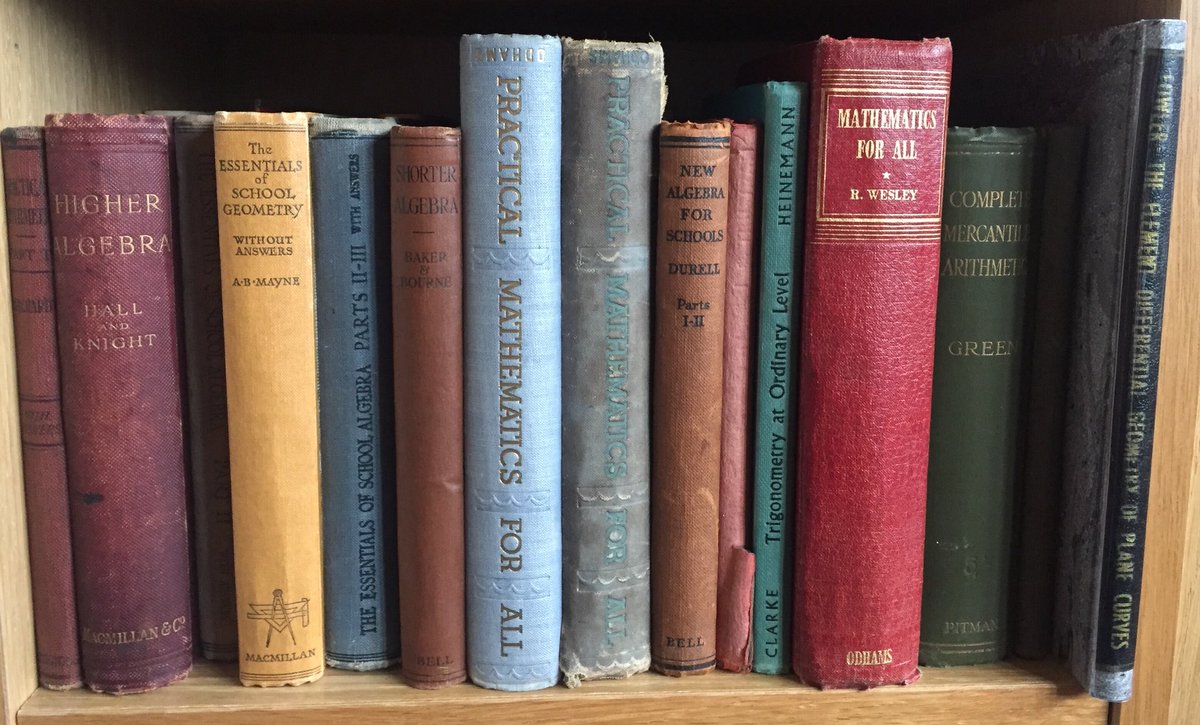Subject knowledge for maths teachers isn't just about being able to do the maths - that's the easy bit - it's also about knowing how to explain concepts clearly, knowing multiple methods and approaches, knowing common misconceptions, knowing history, etymology, narrative and so on. So, in the interest of subject knowledge development, today I bring you some maths from the past. I'm focusing on surds here (because everyone loves surds!), and I hope to bring you similar posts about other topics over the coming months.
Definitions
In Elementary Algebra for Schools (Hall & Knight, 1885), the chapter entitled 'Elementary Surds' starts with some definitions:
Whether we'd still classify those algebraic terms as surds is debatable, but otherwise the wording of the definition ('when a root cannot be exactly obtained') has been pretty consistent over the years. Here it is again in 'A Shorter Algebra' (Baker & Bourne, 1927):
The book later goes on to refer to 'surdic expressions' - I've never used the word surdic and I'd like to see it back in common usage!
In 'The Essentials of School Algebra' (Mayne, 1961) we have the following definition of surd, which offers more clarity by providing a few examples and non-examples:
Note also that surds of order two were sometimes referred to as 'quadratic surds'. This is another expression that we seem to have lost from our secondary school vocabulary. We now deal almost exclusively with quadratic surds, in fact I have seen a number of websites and resources claim that only square roots can be called surds, which is just plain wrong.
Contrast the precise vocabulary and detailed definitions in old textbooks with the disappointing one line description we have in a modern day textbook (Edexcel GCSE Maths, OUP, 2016).
I wonder why textbook authors gave up on thorough definitions.
Justification
Interestingly, old textbooks claim that the use of surds isn't absolutely necessary because, with extensive number work (ie using the process of evolution to find roots), we can find the value of any surd to a suitable degree of accuracy.
Back in the days when maths was all done by hand, they were generally happy with 'accurate enough' and didn't insist on exactness. In fact in 'A Shorter Algebra' it says,
"Results in surds are only practically useful when expressed as decimals".
It seems that although surds were often used for efficient workings, numerical answers were rarely given in surd form. Here we see that rationalising the denominator is done to make numerical calculations easier, because multiplying by a decimal is easier than dividing by a decimal:
Vocabulary
Though we all know and use the phrase 'simplest form' to describe a surd that has been simplified, I'm not sure that many of us use the term 'entire surd' to describe an unsimplifed surd.
Textbooks used to feature exercises where students had to convert simplified surds into entire surds - it's rare to see exercises on this now.
The method for adding surds hasn't changed over the years. We still add 'like surds' or 'similar surds' (perhaps we more often refer to them 'like terms' though),
And the process for rationalising hasn't changed over the last 130 years. We multiply the denominator by a 'rationalising factor'. Where necessary, the rationalising factor will be the conjugate of the denominator. We still refer to the conjugate now - it's good that at least some of the formal language has not been lost.
Of course, standard problems in the 1960s were far harder than they are now.
I don't need to tell you that exercises used to be a lot longer and more challenging than they are in most modern maths classrooms. Here's an example of an exercise on rationalising - this one is from 1885. Note that the first ten questions are just for practising finding the product of two conjugates:
Notice the tricky typesetting of those pesky vinculums!
For comparison, modern textbooks have only half a dozen questions on the same skill.
The books I have been looking at (one from 1885, one from 1927 and one from 1961) continue with square rooting binomial surds and solving 'irrational equations'. I could include a lot more about surds here, but to keep this post to a reasonable length I will leave it there! You get the idea - a lot has changed, all except the mathematics itself.
I've recently bought loads of old textbooks from the early 1900s and am hoping to do a presentation about them at an upcoming conference (possibly #mathsconf17), so if you find this stuff interesting do come along.
 |
| Part of my old textbook collection! |
















Fascinating stuff - thank you so much Jo!
ReplyDeleteWow! I have been enlightened. We rarely used 'entire surd'. Unveiling maths
ReplyDeleteI think the bit rationalizing the denominator because multiplying by a decimal is easier than dividing is fascinating... I always have to shrug when students ask why we should rationalize (i.e. why is a fraction with a radical in the denominator "less simplified"). Now it makes sense. Thanks!
ReplyDeleteExcellent read and interesting piece.Nice one Jo!
ReplyDeleteLooks like there are some great extension questions in these books...
ReplyDelete